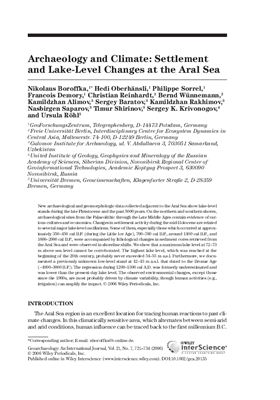Geoarchaeology: An Inteational Joual, 2006, Vol. 21, No. 7,
721–734.
В статье представлены результаты корреляции археологических и
геоморфологических исследований, проводившихся на побережье и
осушенном дне Аральского моря международной группой исследователей.
Уточнена и дополнена шкала регрессий и трансгрессий Аральского
моря, произведена попытка связать падения и повышения уровня моря с
историческими событиями, имевшими место в Приаралье, повлекшими за
собой климатические и социальные изменения в Приаралье.
New archaeological and geomorphologic data collected adjacent to
the Aral Sea show lake-level
stands during the late Pleistocene and the past 5000 years. On the northe and southe shores,
archaeological sites from the Palaeolithic through the Late Middle Ages contain evidence of various
cultures and economies. Changes in settlement activity during the mid-Holocene are related
to several major lake-level oscillations. Some of them, especially those which occurred at approximately
350–450 cal B.P. (during the Little Ice Age), 700–780 cal B.P., around 1400 cal B.P., and
1600–2000 cal B.P., were accompanied by lithological changes in sediment cores retrieved from
the Aral Sea and were observed in shoreline shifts. We show that a maximum lake level at 72–73
m above sea level cannot be corroborated. The highest lake level, which was reached at the
beginning of the 20th century, probably never exceeded 54–55 m a.s.l. Furthermore, we documented
a previously unknown low-level stand at 42–43 m a.s.l. that dated to the Bronze Age
(~4000–3000 B.P.). The regression during 1200–1300 cal A.D. was formerly underestimated and
was lower than the present-day lake level. The observed environmental changes, except those
since the 1960s, are most probably driven by climate variability, though human activities (e.g.,
irrigation) can amplify the impact.
stands during the late Pleistocene and the past 5000 years. On the northe and southe shores,
archaeological sites from the Palaeolithic through the Late Middle Ages contain evidence of various
cultures and economies. Changes in settlement activity during the mid-Holocene are related
to several major lake-level oscillations. Some of them, especially those which occurred at approximately
350–450 cal B.P. (during the Little Ice Age), 700–780 cal B.P., around 1400 cal B.P., and
1600–2000 cal B.P., were accompanied by lithological changes in sediment cores retrieved from
the Aral Sea and were observed in shoreline shifts. We show that a maximum lake level at 72–73
m above sea level cannot be corroborated. The highest lake level, which was reached at the
beginning of the 20th century, probably never exceeded 54–55 m a.s.l. Furthermore, we documented
a previously unknown low-level stand at 42–43 m a.s.l. that dated to the Bronze Age
(~4000–3000 B.P.). The regression during 1200–1300 cal A.D. was formerly underestimated and
was lower than the present-day lake level. The observed environmental changes, except those
since the 1960s, are most probably driven by climate variability, though human activities (e.g.,
irrigation) can amplify the impact.

